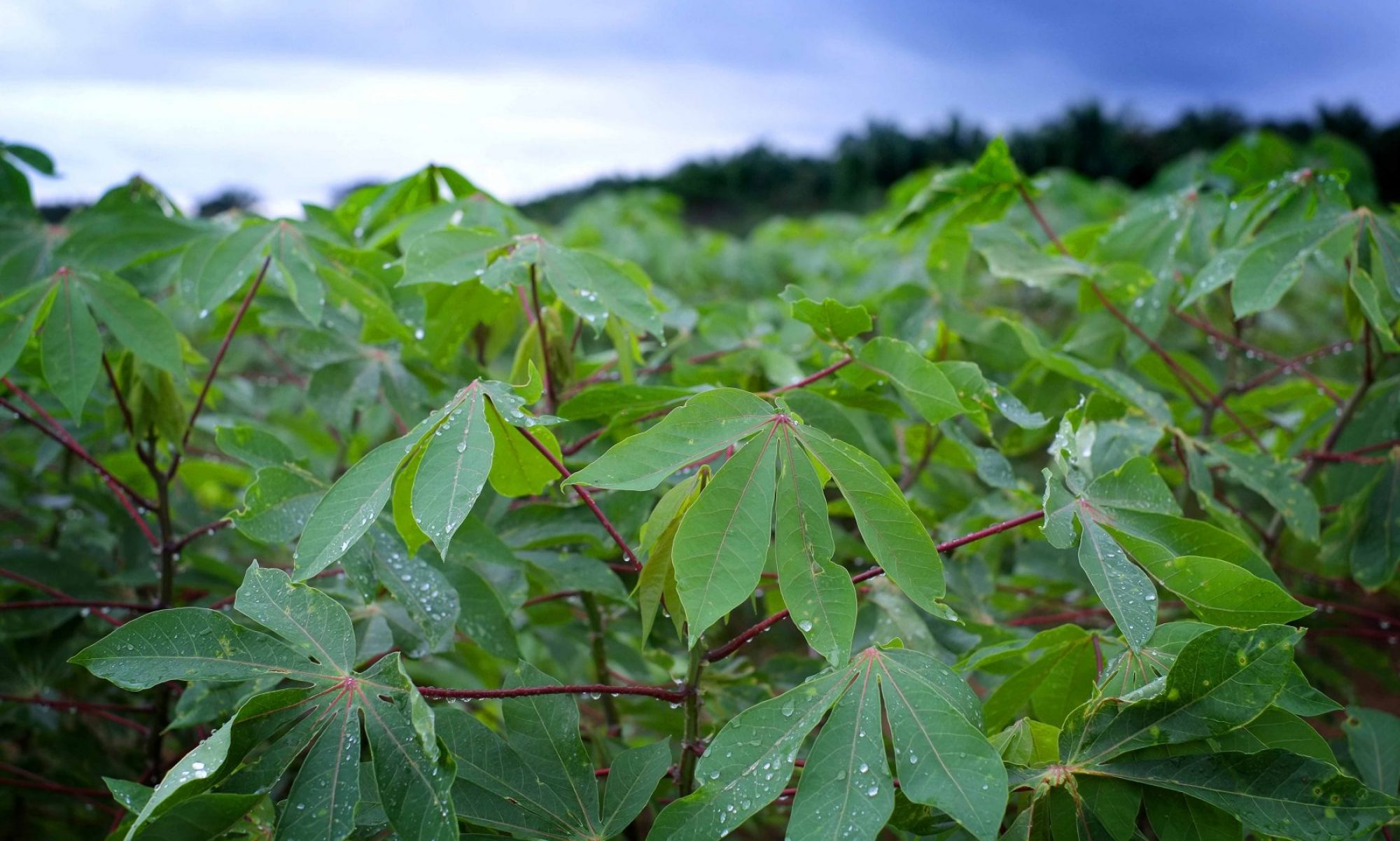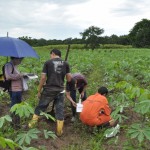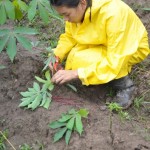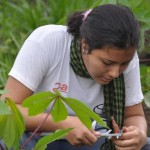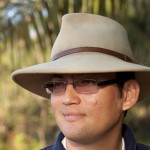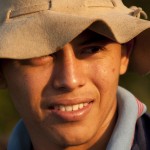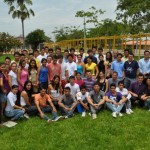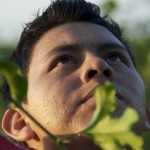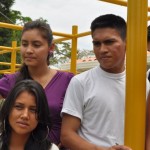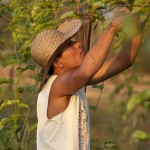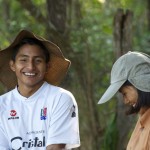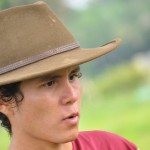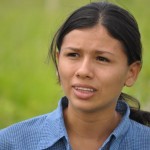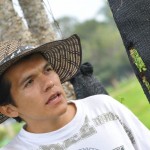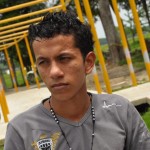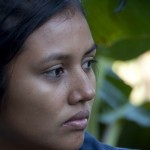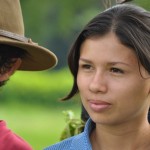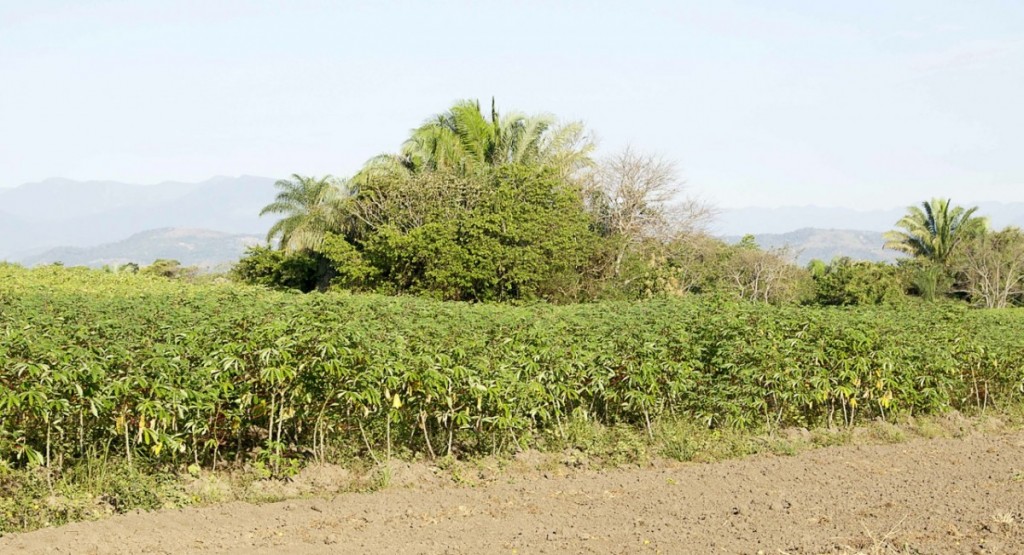
Aims
In our main field trials we investigate how biotechnologically-produced mycorrhizal fungi affect cassava growth. We did this first with commercially-produced AMF with a lot of success. This was to see if concentrated mycorrhizal fungal inoculum in a gel-based carrier will be applicable in the field in Colombia. We use this type of inoculum because it is free of other unwanted microorganisms, it is easy to transport and it is relatively low cost (see Use in Agriculture for more details about why). For results of the first field click here.
The microbial revolution: Towards a mycorrhizal fungus improvement or breeding program
Farmers have been improving crops for millennia without understanding plant genetics. Advances in plant breeding in the 60s-70s largely fuelled the green revolution leading to massive global increases in food production. But increases in yield made by plant breeding are levelling out. We need new technologies. We believe that we can do this with microorganisms like mycorrhizal fungi extending yields beyond those that plant geneticists have already achieved. Click on the image below to see our rationale for the scientific basis for this.
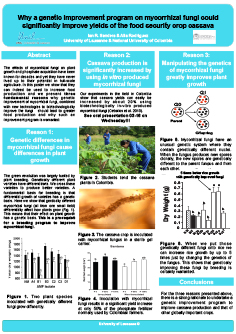
Testing genetically improved mycorrhizal fungi (ongoing): We want to know :
- Do and genetically novel AMF that we have developed in our lab-based research in Switzerland affect cassava growth differently to the commercially-produced AMF inoculum;
- Can we find either crossed or segregated lines that make cassava grow either better or worse than commercially-inoculated or uninoculated plants (click here for a definition of crossed and segregated lines).
- Do the inoculum work in the field, e.g. do they actually colonise the plants?
If the results of these tests yield good results then this provides a strong rational for a genetic improvement or breeding program on mycorrhizal fungi rather than on the plants themselves.
NEWS! Production of AMF for field trials – an initial success !
Other than for the first field trial, we had to first take our novel AMF lines that were developed in Lausanne to the company Mycovitro, in Granada (Spain). Mycovitro successfully produced the inoculum for free for the field trials. This is a very important point because many critics of our work questioned whether our lab-based AMF could ever be produced in large enough quantities in a commercially-based production system. The clear answer to this is, yes! All of the novel AMF that we have generated in Switzerland grow well in the commercial production system and it is easy to produce enough inoculum for either field trails or for large-scale use in agriculture. Taking genetically novel AMF lines from the lab to the field is commercially and economically feasible.
The field site: Utopia Campus of the Universidad de la Salle, Yopal
All our field experiments are located on the Utopia Campus of the Universidad de la Salle which is in Yopal in Colombia. The experiments we run are very large and require a lot of maintenance and a lot of measurements. We are very lucky that the students at Utopia already have quite a lot of experience growing cassava. The photos (right) are taken during the first experiment.
Click here to see where the field site is.
Who does the experiments?
Isabel Cristina Ceballos Rojas is a PhD student at the National University of Colombia in Bogota and funded on our Swiss National Science Foundation project. The questions outlined above form the basis of her PhD work. She is assisted in the field by undergraduate students at the Utopia campus of the La Salle University.
The Utopia agronomy students: Over 20 undergraduate students have taken a very active part in planting the experiment, inoculating the plants, fertilising the plants and making many of the measurements throughout the field experiments. Without their assistance we would simply not have the ability to conduct field experiments on such a large scale. Their enormous enthusiasm for conducting field experiment, as well as their experience in cultivating cassava, has been an enormous advantage to the project.
Here is a list of some of the students who have participated, although more students have worked in the experiments than those listed here ……… sorry if I forgot your name!
Student leaders: Anderson Hidalgo, Camilo Alberto Gutiérrez, Diego Alexander Arias, Erika Tatiana Naranjo, José Irenarco Tapias, Leidy Andrea Barrera, Leonela Yised Nañes, María Idaly Ibáñez, Víctor Fernando Camacho. Additional field assistants: Alberto Fidel Lozano, Álvaro Ángel Arango, Álvaro Javier Silva, Anderson Estepa, Ángel Nolberto Tavera, Audelio Rentería, Diego Pérez, Dumar Sánchez, Efrén Paul Colina, Enrique Arroyo, Erika León, Gildardo Castro, Jorge Pinzón, Karla Angarita, Sara Lucia Rodelo, Víctor Hugo Granados, Walderley Hernández, William Rodríguez, Yuli Castro
Project leaders: Alia Rodriguez (National University of Colombia), Ian Sanders (University of Lausanne), Cristhian Fernandez (La Salle University), Ricardo Peña (La Salle University)
Current state of the project and results: The first field trial was set up several months ago. The final harvest to look at yields of all the different parts of the plant (not just the roots) will take place in April 2012. We will post results about the outcome of these first experiments when we have solid data to present.
Click on any of the images below to see a slide show of the field site and the students
